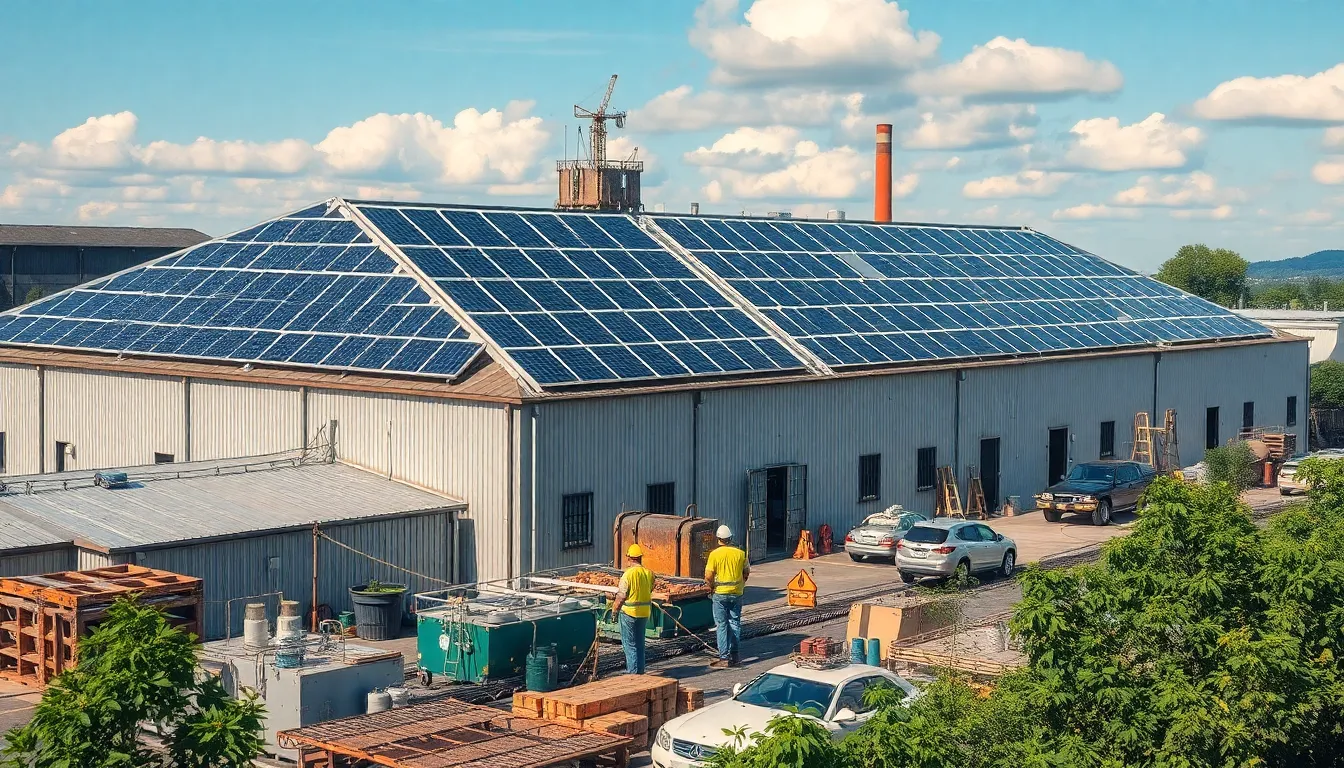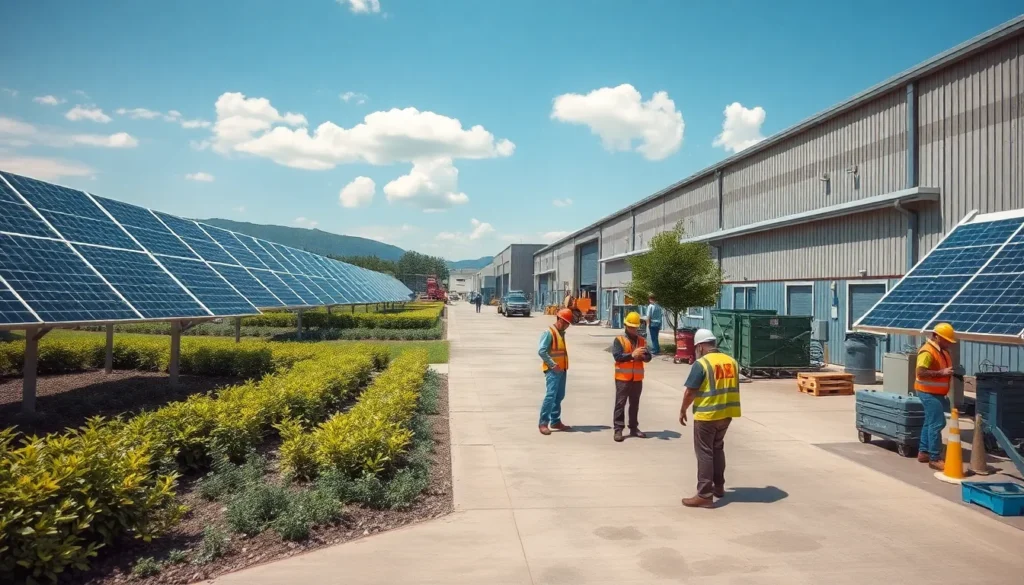Table of Contents
ToggleIn a world where the phrase “going green” has become as trendy as avocado toast, green manufacturing is stepping into the spotlight. It’s not just about saving the planet; it’s about making products in a way that’s as clean as a whistle and as efficient as a squirrel on espresso. Companies are discovering that eco-friendly practices can boost their bottom line while keeping Mother Earth happy.
Imagine a factory where the air smells fresh and the machines hum in harmony with nature. That’s the magic of green manufacturing. By adopting sustainable practices, businesses aren’t just reducing waste; they’re crafting a future where innovation meets responsibility. So, let’s dive into the world of green manufacturing and explore how it’s transforming industries one eco-friendly widget at a time.
Overview of Green Manufacturing
Green manufacturing represents a transformative approach in production processes that minimizes environmental impacts. It emphasizes sustainability, which enhances resource efficiency while reducing waste generation. Companies implementing green practices often use renewable energy sources, leading to a lower carbon footprint.
Innovations in technology drive the adoption of green manufacturing. For instance, advanced waste management systems allow manufacturers to recycle materials effectively, contributing to a circular economy. Eco-design principles guide the development of products that are easier to reuse or recycle, further promoting sustainability.
In addition to environmental benefits, economic advantages become apparent. Studies show that businesses adopting green manufacturing practices can reduce operational costs by implementing energy-efficient systems. Reductions in waste not only lower disposal costs but also enhance overall productivity.
The role of stakeholders plays a significant part in the success of green initiatives. Employees engaged in sustainable practices contribute ideas that drive innovation. Customers increasingly demand environmentally friendly products, prompting companies to adapt their offerings in response to market trends.
Governments also influence green manufacturing through regulations and incentives. Supportive policies can encourage industries to invest in cleaner technologies and sustainable practices. As a result, collaboration between businesses, consumers, and policymakers fosters an environment conducive to sustainable manufacturing.
Overall, green manufacturing reflects a growing commitment to balancing economic growth with environmental stewardship. Embracing this approach not only benefits the planet but also positions businesses competitively in a rapidly evolving market landscape.
Benefits of Green Manufacturing

Green manufacturing offers significant advantages for both the environment and the economy. Companies adopting this approach can achieve sustainability while improving their bottom line.
Environmental Benefits
Green manufacturing reduces waste and promotes efficient use of resources. By utilizing renewable energy sources, factories lower their carbon emissions and minimize air pollution. Advanced waste management systems decrease landfill use, leading to healthier ecosystems. Eco-design principles further support sustainable product development, enabling the creation of goods with reduced environmental impact. Adaptations in production processes enhance overall energy efficiency, resulting in lower resource consumption. Sustainable practices contribute to biodiversity conservation, ensuring a cleaner environment for future generations.
Economic Benefits
Economic advantages accompany the shift toward green manufacturing. Organizations frequently experience reduced operational costs by implementing energy-efficient systems. Waste reduction strategies generate savings by minimizing disposal fees and material costs. Enhanced brand reputation attracts environmentally conscious customers, driving sales. Stakeholders, including employees and consumers, actively support companies that prioritize sustainability, fostering loyalty. Compliance with government regulations often results in financial incentives, encouraging investment in greener technologies. Ultimately, the integration of eco-friendly practices positions businesses competitively within the market, driving innovation and growth.
Key Principles of Green Manufacturing
Green manufacturing operates on fundamental principles that drive sustainability and efficiency. Two key principles are resource efficiency and waste reduction.
Resource Efficiency
Resource efficiency focuses on maximizing the use of inputs while minimizing waste. Companies often adopt energy-efficient technologies to lower consumption across operations. Implementing renewable energy sources leads to a substantial reduction in reliance on fossil fuels. Effective training for employees improves material usage, cutting down on excess. Additionally, companies embracing resource efficiency often report significant cost savings, fostering a competitive advantage. Adopting closed-loop systems enables manufacturers to reuse materials, thereby enhancing overall productivity.
Waste Reduction
Waste reduction prioritizes minimizing waste generation throughout the manufacturing process. Businesses implement advanced waste management strategies to recycle, compost, or repurpose materials. Engaging employees in sustainability initiatives empowers them to develop innovative solutions to reduce waste. Eco-design principles encourage the creation of products that generate less waste at the end of their lifecycle. Continuous improvement processes require regular assessments of output, allowing companies to identify areas for reduction. Ultimately, effective waste management leads to a cleaner environment and improved profit margins for manufacturers.
Technologies in Green Manufacturing
Innovative technologies play a crucial role in advancing green manufacturing. They enable companies to adopt more sustainable practices while minimizing environmental impacts.
Renewable Energy Sources
Solar, wind, and hydropower are leading renewable energy sources in green manufacturing. Factories increasingly utilize solar panels to harness sunlight, generating clean electricity. Wind turbines capture wind energy, providing significant power for production processes. Hydropower plants supply energy through flowing water, adding to the renewable mix. Integrating these energy sources reduces reliance on fossil fuels, lowering carbon emissions considerably. Companies that adopt renewable energy not only improve their sustainability but also benefit from long-term cost savings. Strategic investment in these technologies aligns with environmental regulations, promoting cleaner operations.
Sustainable Materials
Sustainable materials include recycled, biodegradable, and sustainably sourced options. Businesses that prioritize using recycled materials reduce waste and lower their environmental footprint. Biodegradable materials break down naturally, minimizing landfill impact. Sourcing raw materials from certified sustainable suppliers supports responsible forestry and responsible sourcing. The adoption of sustainable materials often enhances product appeal to eco-conscious consumers, driving market demand. As innovations in sustainable materials continue, manufacturing processes can further decrease their ecological impact. Companies with sustainable material usage often experience improved brand loyalty and customer satisfaction.
Challenges in Implementing Green Manufacturing
Adopting green manufacturing presents various challenges that companies must navigate. Understanding these obstacles helps organizations make informed decisions.
Cost Implications
Organizations often face high initial costs when transitioning to green manufacturing. Investment in renewable energy sources and advanced technologies can strain budgets. Over time, cost savings from energy efficiency and waste reduction can offset these initial expenses. Compliance with environmental regulations may also incur additional costs. Companies with limited financial resources may struggle to balance upfront investments with long-term sustainability goals.
Technology Adoption
Technological advancement plays a crucial role in green manufacturing. Integrating new systems requires time and training for employees. Resistance to change can hinder the implementation of innovative solutions. Additionally, accessing cutting-edge technologies may pose challenges for smaller firms with limited resources. To bridge this gap, companies must prioritize investment in training and education. Successful adoption can lead to improved processes and reduced environmental impact, enhancing overall competitiveness.
Green manufacturing is more than a trend; it’s a vital shift towards a sustainable future. By embracing eco-friendly practices, companies can not only reduce their environmental impact but also enhance their profitability. This approach fosters innovation and encourages collaboration among stakeholders, paving the way for a cleaner and more efficient industrial landscape.
As industries continue to evolve, the integration of renewable energy and sustainable materials will play a crucial role in shaping their success. While challenges exist, the long-term benefits of green manufacturing far outweigh the initial investment. Ultimately, businesses that prioritize sustainability will not only secure a competitive edge but also contribute to a healthier planet for future generations.







